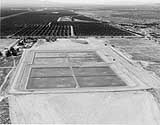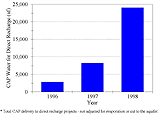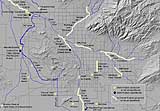|

![[continued]](chap3_06_files/cont.gif)
Little of the CAP water recharged in TAMA so far has been pumped for
use, although the City of Tucson is constructing a wellfield to allow
recovery of water stored at the Central Avra Valley Storage and Recovery
Project (CAVSARP) in the near future. Generally, recovery of recharged
water is permitted if it is recovered in the area where the water was
originally stored, or in an area to which it migrated after storage.
Recovery of water outside this “area of impact” is permitted under certain
conditions to ensure that recovery of water does not occur in areas with
substantially declining groundwater levels.
Figure 3-11 is a map of existing and proposed direct recharge
facilities in TAMA. Four direct recharge facilities are currently
operating in TAMA. These include CAVSARP, Pima Mine Road Recharge Project,
Avra Valley Recharge Project and Sweetwater Underground Storage and
Recovery Project. All of these projects utilize off-channel spreading
basins to recharge CAP water, except the Sweetwater facility, which uses
basins to recharge reclaimed effluent.
 |
| Figure 3-9 The Pima Mine Road
recharge basins. Photo: Central Arizona Water Conservation
District. |
Figure 3-10 shows the amount of water stored at direct recharge
facilities over time. The amount of water stored at Tucson area projects
is small compared to the total renewable supplies available. Not including
CAP water used at groundwater savings facilities, about 7,800 acre-feet of
CAP water was recharged in TAMA in 1997, compared to approximately 215,000
acre-feet of CAP water available under sub-contract to entities in TAMA.
 |
| Figure 3-10 CAP water deliveries to
direct recharge projects in the Tucson AMA.Source: Central
Arizona Water Conservation District. |
Direct injection is the most certain method of recharge because water
can be directed to a specific location within an aquifer. For this reason,
local recharge experts believe that direct injection may be the most
effective tool in mitigating subsidence. With direct injection, water can
be added as close as possible to the layers of the aquifer that are being
compacted. The extent to which subsidence can be limited with this method,
however, is uncertain, depending in part on the type of aquifer materials.
Tucson Water stored approximately 4,000 acre-feet of CAP water using two
pilot injection wells in 1993 and 1994. The Water Consumer Protection Act,
however, allows direct injection only if the water meets or exceeds the
water quality of Avra Valley groundwater in terms of hardness, salinity
and dissolved organic materials and is free of disinfection by-products.
Costs of treating CAP water to the Avra Valley groundwater standards would
be prohibitively expensive. Entities in the Tucson area other than Tucson
Water are not bound by WCPA but have not attempted direct injection.
 |
| Figure 3-11 Existing and proposed
direct recharge projects.Source: Arizona Department of Water
Resources |
New direct recharge projects are being planned. (See Figure 3-11.) A
facility permit has been issued for the Lower Santa Cruz Replenishment
Project, which is projected to have a capacity of 12,000 to 13,000
acre-feet in its first phase. The facility will be located along the Santa
Cruz River in northern Avra Valley. The proposed Cañada del Oro Recharge
Project could add another 30,000 acre-feet of direct recharge capacity in
northwest Tucson near the Town of Oro Valley. A study of the technical
feasibility of the project is currently being conducted. Total direct
recharge capacity on non-Indian land in TAMA is projected to be 49,000
acre-feet in the year 2000, possibly rising to 131,000 by the year 2007
with the addition of a full-scale Lower Santa Cruz Replenishment Project,
the Cañada del Oro Project and expansion of existing projects to
full-scale. Proposed recharge projects on Indian land could add up to an
additional 41,000 acre-feet of direct recharge capacity b y 2007.
TYPES OF ARTIFICIAL RECHARGE
In-Channel Artificial Recharge
Artificial recharge facilities operate either in-channel or
off-channel. In-channel constructed facilities are recharge
facilities built into a river or stream bed to retain water while it
infiltrates through the stream bed into the underlying aquifer.
These structures include inflatable dams, gated structures, levees
and basins, or other devices designed to impede water flow. Levees
are the least expensive of these alternatives, but are the most
subject to damage from flood flows. Also operating in-channel,
managed facilities allow water to infiltrate the stream channel
without the aid of structures to impede flow. Off-Channel
Artificial Recharge
Off-channel artificial recharge facilities include shallow
spreading basins. These basins are dug up to 20 feet deep to reach
more permeable layers and are usually constructed with earthen berm
walls to hold water in place. During operation, the depth of water
usually does not exceed five feet. Basins are operated on a wet/dry
cycle to allow periodic scrapings or other techniques to maintain
high infiltration rates.
Deep basins or pits also can be used for off-channel recharge.
These facilities are usually converted from other uses, such as
gravel pits. During operation, water levels up to about 10 feet are
usually maintained. Operating costs are usually low, since basins
are drained and maintained only once every year or two. Infiltration
rates, however, are usually low due to build up of organic matter.
Also operating off-channel, injection wells are usually existing
water extraction wells converted to allow injection of water
directly into the aquifer. Water injected must normally meet
drinking water standards (Maximum Contaminant Levels). The Water
Consumer Protection Act effectively prohibits the City of Tucson
from using injection wells unless the water injected is treated to
the same standards as Avra Valley groundwater and is free of
disinfection byproducts.
|
|




